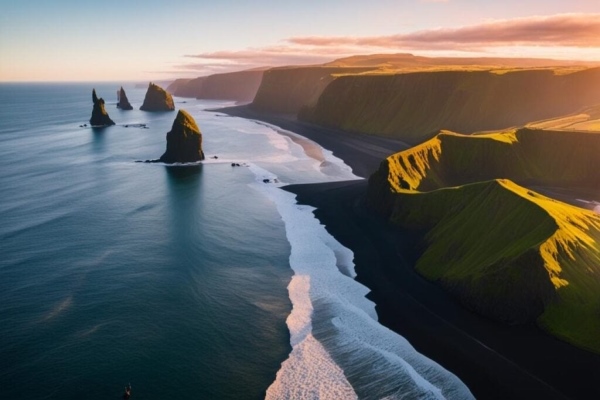Key Takeaways:
- Black sand beaches are visually striking and bear significant geological evidence.
- They provide a unique habitat for various species and often have fascinating cultural stories attached to them.
- Visitors should know these beaches' natural beauty and potential safety concerns.
Introduction to Black Sand Beaches
Black sand beaches captivate visitors with their distinct, dramatic landscapes that contrast sharply with the usual soft golden or white sand hues. These beaches are remarkable for their stunning appearance and the stories they tell about our planet's geological history. A prime example is the diverse black sand beach, a testament to volcanic activity and its enduring impact on the earth's surface. While predominantly found in volcanic regions, like the stark coastlines of Iceland or the exotic shores of Hawaii, these beaches offer an unparalleled glimpse into nature's artistry in action.
Although they may seem rare, these beaches are scattered worldwide, each offering more than just raw beauty. They are natural relics that speak volumes of the powerful geological forces that sculpt our environment, often revealing the dynamic interplay between tectonic movements, volcanic eruptions, and oceanic interactions. Their unique nature invites travelers from far and wide, enticing them to experience firsthand the wonder and power of Earth’s creative processes.
Geological Formation
The striking color of black sand beaches owes itself primarily to the dynamics of volcanic activity. The sand, composed largely of volcanic minerals and fragmented lava, results from the interaction between hot molten lava and the cool, pounding waves of the ocean. As the lava cools rapidly upon contact with water, it shatters into fine particles, creating the distinctive black sands that characterize these extraordinary coastlines.
Over decades and centuries, the elements further break down these volcanic fragments. Continuous exposure to the relentless forces of waves and weather contributes to a sandy landscape that seems almost alien to more conventional beaches. In some parts of the world, such geological activity is ongoing, offering a live spectacle of the forces shaping these mesmerizing landscapes. A black sand beach is a direct result of this volcanic process, where eroded lava and basalt create a striking contrast to the typical golden or white sands found elsewhere. Such natural artistry highlights the mutable nature of Earth’s surface, painting a vivid portrait of how land, water, and fire interact across geological timeframes.
Unique Ecosystems
Beyond their visual allure, black sand beaches act as thriving habitats, home to unique ecosystems that support diverse flora and fauna. These environments challenge life forms with extreme conditions, such as heat absorption from the dark sand and mineral-rich soil. However, select species have adapted remarkably, demonstrating nature’s resilience and ingenuity. Coastal vegetation, which grips tenaciously to the shifting sands, is crucial in stabilizing these beaches, offering vital habitats for terrestrial and marine life.
The adaptation strategies of species inhabiting these ecosystems are a fascinating subject of ongoing scientific research. Insights into these strategies enhance our understanding of ecological resilience and evolution. Learn more about these ecosystems through recent studies, which contribute significantly to ecological research and conservation efforts worldwide. Protecting these environments is essential, not only for the unique species they harbor but also for maintaining the ecological balance that supports the broader environmental health of our planet.
Popular Black Sand Beaches Around the World
Among the most celebrated black sand beaches is Reynisfjara Beach in Iceland, famed for its basalt columns and the constant crashing of the Atlantic Ocean against its shores. With its towering cliffs and geometric rock formations, this beach provides a breathtaking view, drawing photographers and adventurers alike to its dramatic beauty and natural wonders.
In contrast, Hawaii’s Punalu’u Beach presents a more tranquil scene, where sea turtles emerge from the waves to bask on the warm sand framed by a lush, green backdrop. These turtles have become iconic beach symbols, embodying the harmonious interaction between local wildlife and the environment. Each black sand beach has unique features that set it apart, offering intrigue and wonder that captivate the imagination. From New Zealand’s wild coastlines to the enchanting Canary Islands, these beaches inspire awe and reverence for nature’s unyielding creativity and grandeur.
Cultural Significance
Beyond their geological and ecological importance, many black sand beaches hold rich cultural and mythical significance. In Hawaii, the native spiritual traditions regard these beaches as sacred sites imbued with mana, or spiritual energy. They tell of ancient tales where gods and goddesses etched their legacies into the landscape through powerful natural events, linking the mystical past to the natural beauty that surrounds visitors today.
Such stories animate the landscape, luring explorers not just with visible beauty but with stories that promise adventure and mystery. For many communities, these beaches are integral to their cultural identity and environmental stewardship, preserving the tales and natural beauty for future generations while promoting sustainable tourism practices.
Precautions for Visitors
Visiting a black sand beach can be a truly unforgettable experience, but preparation is key. Due to their volcanic origin, these beaches can have stronger currents and unique weather patterns. Local conditions should be checked beforehand, and visitors should heed official warnings or advice to ensure a safe experience.
Equally important is the need to preserve these pristine environments for future generations. Visitors are urged to respect local conservation efforts by minimizing their ecological impact—whether it involves refraining from removing sand, respecting local fauna, or avoiding littering. By doing so, we support the mission to safeguard these natural treasures, ensuring they inspire awe and appreciation for years.
Scientific Research and Environmental Concerns
Ongoing scientific research aims to deepen our understanding of black sand beaches' complexities and ecological significance. These studies enhance our knowledge of Earth’s natural processes and play a critical role in developing strategies that mitigate potential environmental impacts. As these dynamic environments face increasing tourism and climate change pressures, scientific insights are crucial for informing conservation actions.
The environmental concerns surrounding black sand beaches often center around their vulnerability to erosion and degradation due to human activity and the broader impacts of climate change, such as rising sea levels. As scientists continue to explore the intricate balance within these ecosystems, explore ongoing research that underscores the importance of proactive environmental stewardship. Safeguarding these unique landscapes demands our collective effort to promote sustainable practices that honor the delicate bond between humanity and nature.
Conclusion
Black sand beaches are more than just a feast for the eyes; they are a colossal archive reflecting Earth’s dynamic forces and the intricate interplay of geological phenomena over time. By presenting opportunities to explore geology, ecology, and cultural heritage, these landscapes invite appreciation and inspire a respectful attitude toward their enduring beauty and complexity.
By fostering a spirit of responsible exploration and preservation, we ensure that these captivating landscapes continue to inspire and educate future generations. Encouraging sustainable tourism practices and respecting these sites' natural and cultural significance helps maintain their role as custodians of history and natural beauty, enriching our global heritage.
For More Biography, Gossip, Follow Legends Bio.
















